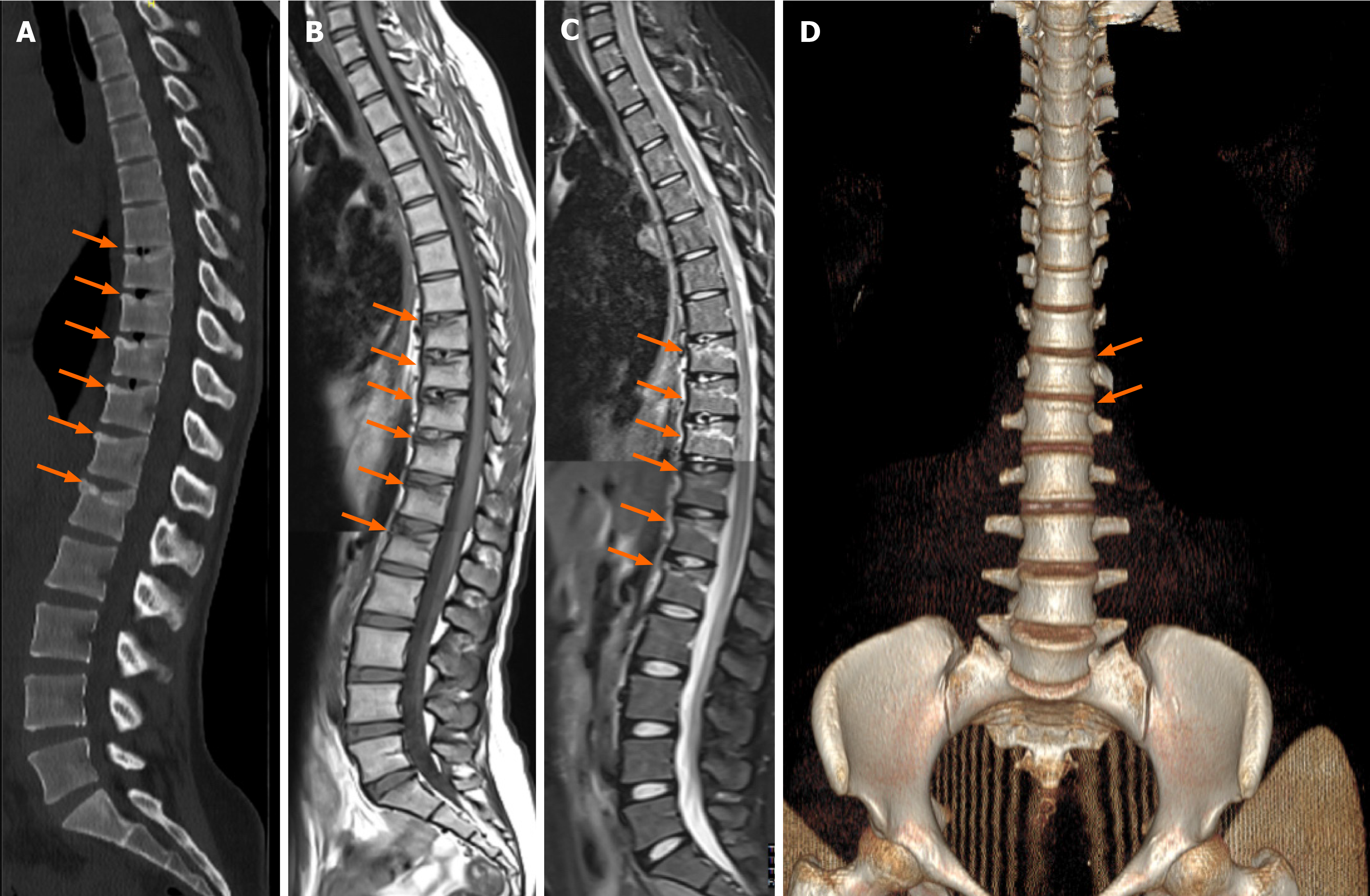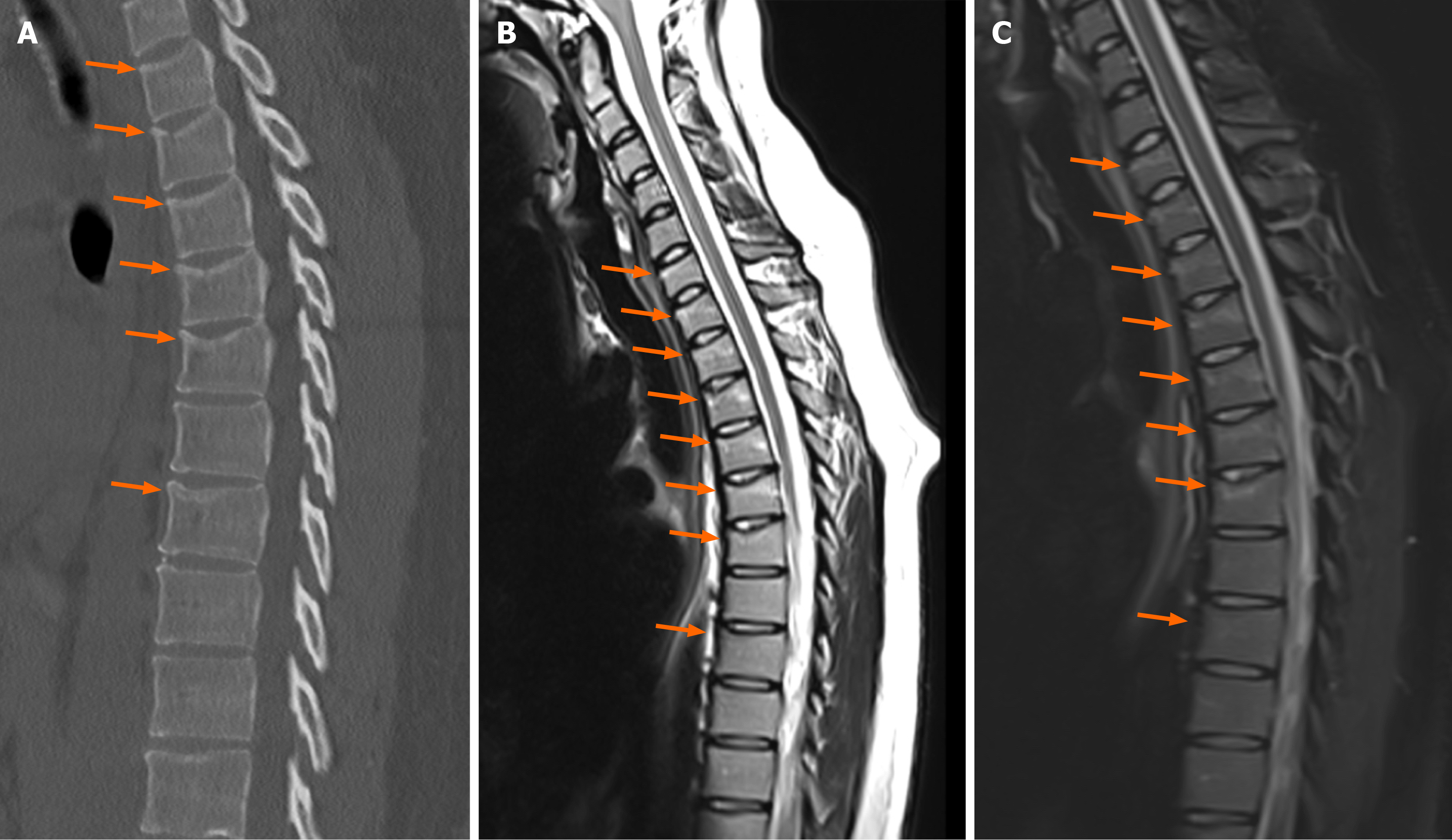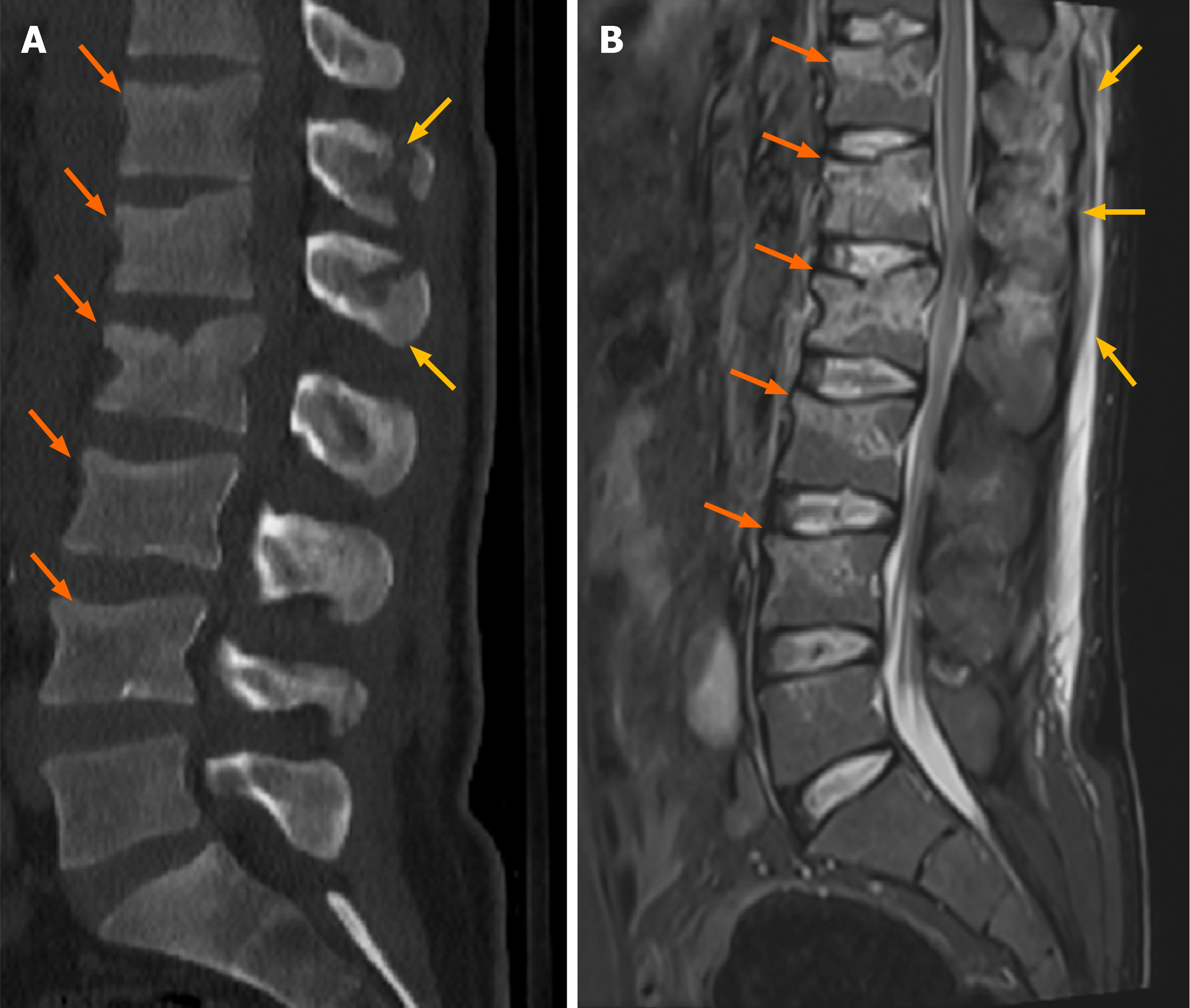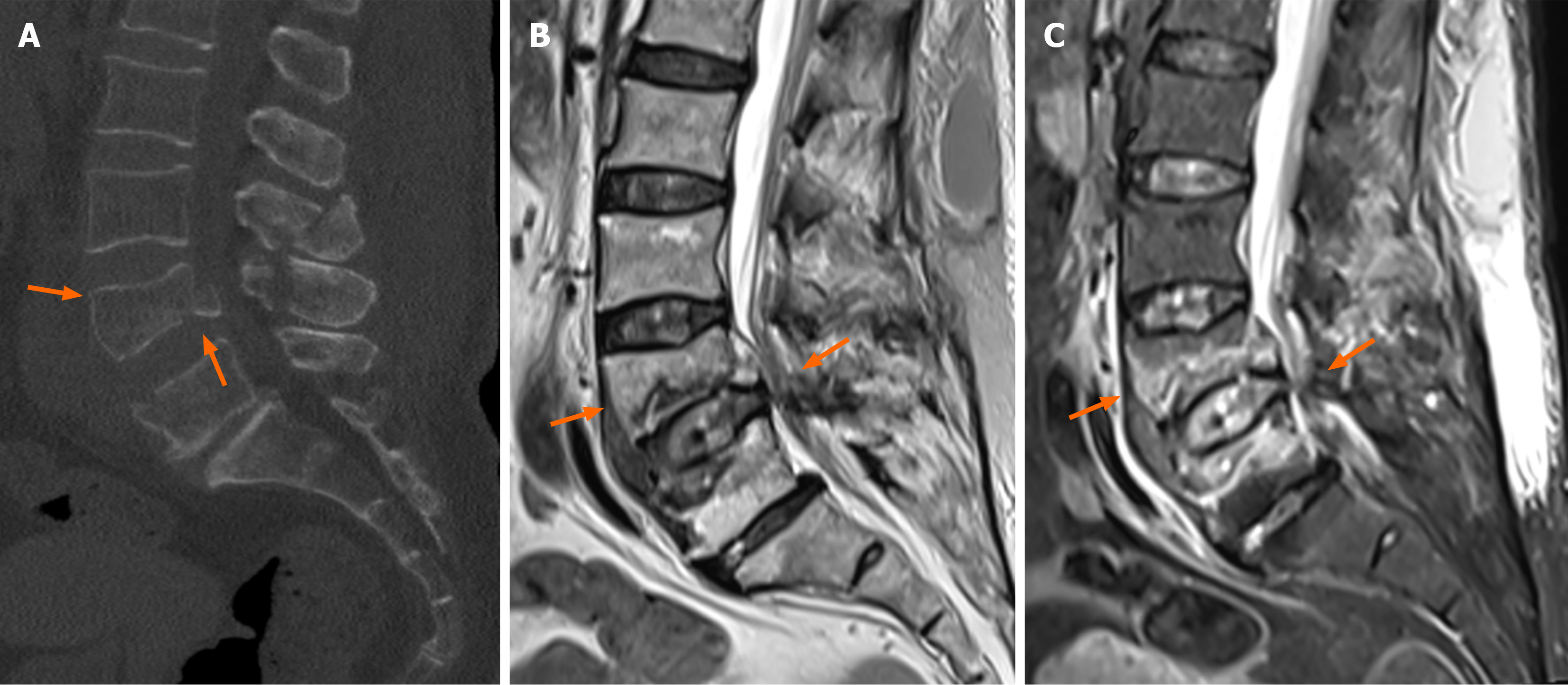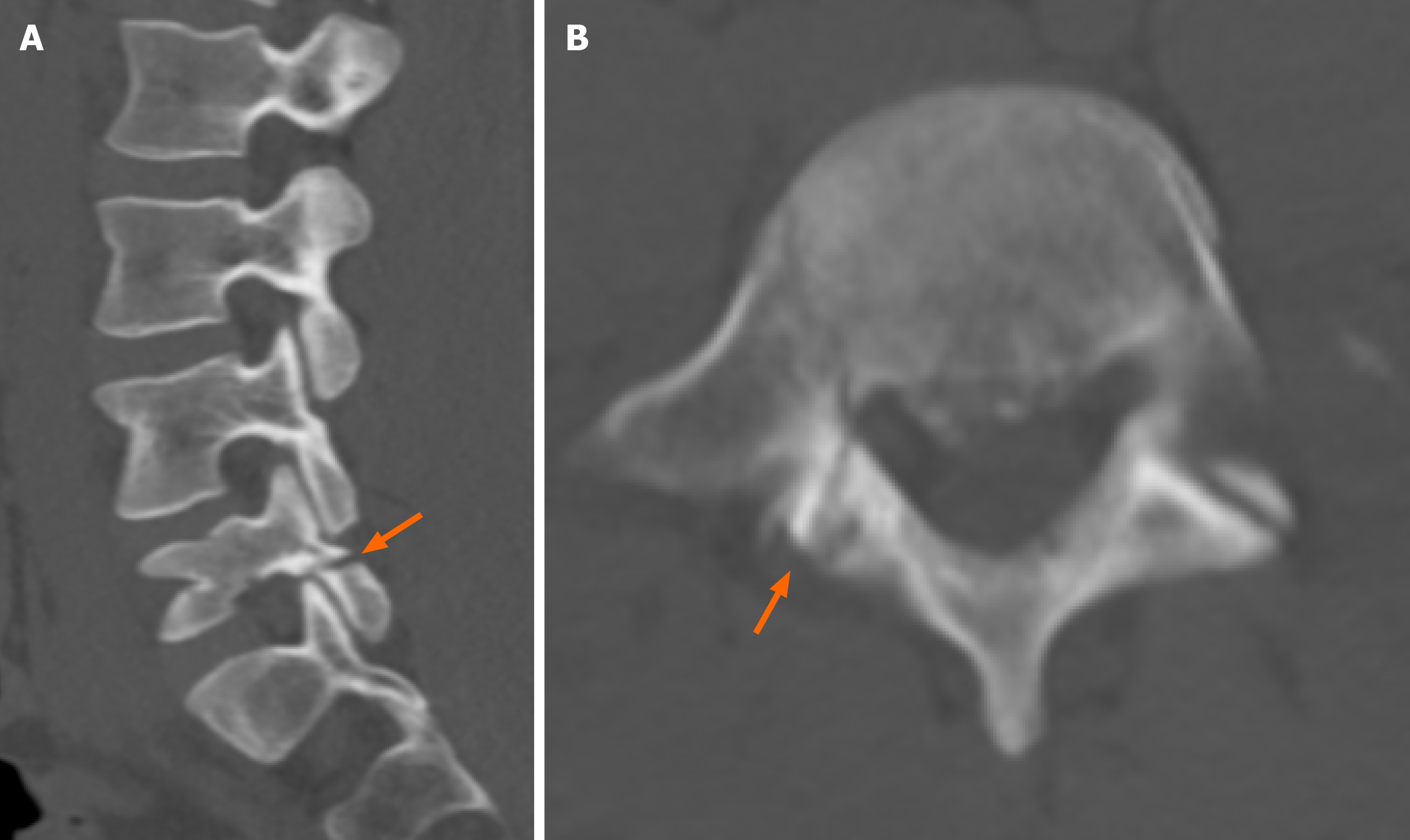Published online Sep 28, 2024. doi: 10.4329/wjr.v16.i9.398
Revised: August 20, 2024
Accepted: August 28, 2024
Published online: September 28, 2024
Processing time: 122 Days and 10.2 Hours
The February 6, 2023, twin earthquakes in Türkiye caused significant structural damage and a high number of injuries, particularly affecting the spine, which underscores the importance of understanding the distribution and nature of ver
To investigate the distribution of radiological findings of vertebral injuries in pa
With the approval of the institutional ethics committee, 1216 examinations of 238 patients transferred from the region to a tertiary major hospital after the twin earthquakes of February 6, 2023, were retrospectively analyzed for spine injuries.
Spine computed tomography (CT) scans were performed in 192 of 238 patients with a suspected spinal injury, 42 of whom also had an magnetic resonance imag
Our study highlights the prevalence and diverse spectrum of spinal injuries following the February 6, 2023 twin earthquakes in Turkey underscoring the urgent need for effective management strategies in similar disaster sce
Core Tip: In the classification of damages from the earthquakes in Turkey on February 6, 2023, it was found that the injuries were predominantly crush-related rather than escape-related. Observations revealed that patients frequently sustained damage to the thoracolumbar regions due to prolonged fetal positioning under debris. It was determined that a significant portion of patients with spinal canal injuries had damage consistent with the thoracolumbar junction.
- Citation: Bolukçu A, Erdemir AG, İdilman İS, Yildiz AE, Çoban Çifçi G, Onur MR, Akpinar E. Radiological findings of February 2023 twin earthquakes-related spine injuries. World J Radiol 2024; 16(9): 398-406
- URL: https://www.wjgnet.com/1949-8470/full/v16/i9/398.htm
- DOI: https://dx.doi.org/10.4329/wjr.v16.i9.398
The catastrophic twin earthquakes measuring 7.8 and 7.7 on the Richter scale struck Kahramanmaraş, Turkey, on February 6, 2023, marked a shattering chapter in the region's history, claiming the lives of over 50000 people and leaving thousands more injured[1,2]. The aftermath of these seismic events, saw a saturation of health services, as the scale of the devastation exceeded the capacity of local medical facilities. Unlike other natural disasters, earthquakes impose a disproportionately high toll on human lives, underscoring the urgent need for effective response mechanisms in the face of such crises[3]. Among the myriad of injuries, spinal trauma is of particular concern as it affects a significant proportion of earthquake survivors. In particular, the unique circumstances surrounding these injuries, including the prevalence of crush injuries and falls, pose a particular challenge in diagnosis and treatment[4].
Following the earthquakes, the increase in crush injuries and falls precipitated a wave of spinal trauma that strained already overstretched healthcare resources[5]. Notably, earthquake survivors were found to be at heightened risk of developing crush syndrome, a potentially life-threatening condition characterized by the myonecrosis, rapid hypovole
Compression fractures typically occur due to axial loading, where the vertebral body is crushed under excessive pressure, leading to a wedge-shaped deformity. Of particular concern was the emergence of a specific injury pattern known as "forced prolonged fetal posture", observed predominantly among earthquake survivors and requires specia
The main objective of this paper is to describe the distribution and characteristics of spinal injuries in the survivors of the February 6 twin earthquakes. By analyzing multidetector row computed tomography (CT) and magnetic resonance imaging (MRI) findings from a cohort of individuals who had spinal injuries after the earthquake, we attempt to clarify the incidence and patterns of spinal trauma in this population.
The study was conducted following the guidelines of the Declaration of Helsinki and approval for this retrospective study was obtained from the Institutional Ethics Board. Our study included patients who were referred to our hospital from the disaster area during the period from February 6 to February 28, 2023. We included all patients from the disaster area in our study, without considering any age restrictions.
All CT examinations were performed in the emergency radiology station, via Somatom Perspective 64-Slice Siemens® CT device (Erlangen/Germany). CT scan parameters were as follows: Tube voltage: 120 kV, tube current set with optimized automatic exposure control (the ref mAs value of CT was 140 mAs), collimation thickness: 0.6-2 mm, tube rotation time: 0.6-1 seconds and collimated section thickness: 2-5 mm. The iterative reconstruction (ADMIRE, strength 2) with 30 seco
MRI imaging was performed with a Siemens® 1.5 Tesla Aera device (Erlangen/Germany). Imaging parameters for the cervical, thoracic, lumbar and sacral regions included a slice thickness of approximately 3-5 mm, a repetition time of approximately 2000-2500 ms, an Time to Echo of approximately 20-40 ms, a matrix size of approximately 256 × 256 and a field of view of 200-350 mm, depending on the region scanned. The MRI protocol for the spine examination included axial T1-weighted, axial T2-weighted, axial fat-suppressed T2-weighted, sagittal T1-weighted, sagittal T2-weighted, and sagittal fat-suppressed T2-weighted sequences.
All CT and MRI examinations of the spine of these patients were included in the study. The distribution of spinal fractures across the anatomical regions, including the cervical, lumbar, thoracic and sacral regions, was delineated. Fractures were categorized using the Denis, Association for Osteosynthesis (AO), and TLICS classifications[10-13]. Pa
Statistical analysis included descriptive statistics and incidence calculations to describe the distribution of CT and MRI findings of spinal fractures and to investigate consecutive spinal fractures due to prolonged fetal position.
1216 examinations were carried out on 238 patients who were transferred from the disaster area to our hospital. Of these, 192 patients underwent a CT scan and 42 an MRI scan. Of the 192 CT scans, 163 examinations of the cervical, thoracic and lumbar vertebra were performed, while the remaining scans examined specific anatomical regions based on clinical symptoms.
Of the patients who underwent CT scans, 86 patients had vertebral fractures, of which 63 (73.25%) had multiple fractures and 23 (27.75%) had single fractures. Total fracture number was 287. In addition, 47 patients out of 63 (74.60%) with multiple fractures had consecutive fractures, while 16 patients (25.40%) had scattered fractures. Grouping patients according to TLICS groups of involvement revealed various types of vertebral fractures, including 40 compression fractures, 17 burst fractures, 5 flexion-distraction fractures, 5 translational dislocation fractures, and 58 fractures due to prolonged fetal posture. For examples of vertebral fractures in these patients, please see Figures 1, 2, 3, 4, and 5.
Most injuries occurred in the lumbar region. Sixty-three patients out of 86 patients (73.25%) sustained lumbar vertebra fractures. Furthermore, 140 vertebral fractures were assessed within lumbar region. Of these 63 patients, 33 patients (52.38%) had type B fractures according to the Denis classification, and 26 patients (41.26%) had type A4 fractures acco
Injuries to the thoracolumbar junction (T10-L2) were most common in earthquake victims. Fifty-eight patients had fractures at this level with total 93 fractures. Looking at the distribution of thoracolumbar region injuries based on their vertebral levels, ten (10.75%) fractures were at the T10 Level, sixteen (17.20%) at the T11 level, nineteen (20.43%) at the T12 level, twenty-three (24.73%) at the L1 level and twenty-five (26.88%) at the L2 level. In addition, according to the Denis classification, 27 of them had unstable 3-column fractures in the lumbar region.
Fractures affecting the thoracic vertebrae were identified in 48 out of 86 earthquake victims. Among detected 287 vertebral fractures, 131 were localized to the thoracic vertebrae. Patients with thoracic fractures had different fracture types, with A0 fractures being the most common. Of the 48 patients with thoracic vertebral fractures, 13 patients (27.08%) had thoracic A0 fractures with 44 A0 fractures (33.58%) identified among the 131 thoracic vertebral fractures. According to the Denis classification, nine patients had unstable 3-column fractures in the thoracic region.
No unstable 3-column fractures were observed in patients with cervical vertebral fractures. Ten patients with fractures in the sacral region were grouped according to the Denis zonal distribution classification, and an equal number of zone 2 and zone 3 fractures were observed.
Concomitant fractures in patients with vertebral fractures included ribs (43), upper extremities (10), lower extremities (19), scapulas (11), sternum (4), viscerocranium (6), clavicles (6), and neurocranium (2).
MRI showed retropulsion and narrowing of the spinal canal in 12 patients, and CT showed this in 19 patients. When examining the distribution of fractures causing spinal canal narrowing with retro-pulsed fragments, the most common fractures occurred at the L1 vertebra in 7 patients, followed by the T12 and L2 vertebrae in every three patients, the L4 vertebra in 2 patients, and one patient each in the L3, L5, T11, and T9 vertebrae.
Detailed information on the distribution of fracture types and the positive CT and MRI findings can be found in Tables 1, 2 and 3.
| Total number of patients | Positive findings (%) | Gender distribution (%) | Mean age | Standard deviation | Median |
| CT (192) | 86 (44.79) | Female: 53 (61.62); Male: 33 (38.37) | 45.25 | 19.56 | 46.00 |
| MRI (42) | 33 (78.57) | Female: 20 (60.60); Male: 13 (39.39) | 52.00 | 19.91 | 55.00 |
| Injury type | Number of patients (86 pts w 287 vertebra fractures) (%) | Mean age | Standard deviation | Median |
| Compression | 40 (46.51) | 40.82 | 20.97 | 38.50 |
| Burst | 17 (19.76) | 53.47 | 18.53 | 61.00 |
| Translation dislocation | 5 (5.81) | 49.40 | 14.97 | 52.00 |
| Flexion distraction | 5 (5.81) | 30.20 | 17.66 | 26.00 |
| Isolated transverse or spinous process fracture | 18 (20.93) | 49.88 | 15.72 | 52.00 |
| Prolonged fetal posture injury | 58 (67.44) | 45.22 | 19.52 | 48.00 |
| Denis | Number of patients (86 pts w 287 vertebra fractures) (%) | Mean age | Standard deviation | Median |
| B | 33 (38.37) | 40.06 | 22.04 | 36.00 |
| C | 4 (4.65) | 54.00 | 11.31 | 54.00 |
| D | 20 (23.25) | 50.75 | 18.38 | 60.00 |
| E | 11 (12.79) | 43.09 | 20.95 | 52.00 |
The twin earthquakes that struck southeastern Turkey on February 6, 2023, represent a major disaster. Considering the persistent presence of humanity, various types of disasters, especially earthquakes, remain inevitable. A critical aspect requiring attention among earthquake victims is the incidence of vertebral fractures, as documented in the existing literature from various earthquakes worldwide and corroborated by our observations following the twin earthquakes[5,14]. Analysis of earthquake victims reveals that a substantial portion sustain injuries from being trapped under debris, while others experience vertebral fractures during attempts to escape the earthquake's effects. Li et al[15] demonstrated in their research (focused on an earthquake with a magnitude of 8.0) that crush-related injuries constitute the majority of cases; similarly, our study found that most patients were trapped under debris. Consequently, contrast material exami
In our earthquake-related cohort, the risk of lumbar spinal injury due to retro-pulsed bony fragments was most pre
A study examining spinal fractures during the Wenchuan earthquake (with a magnitude of 8.0) identified burst and compression fractures as the most prevalent types[15]. Similarly, in our patient group, compression fractures emerged as the most frequently observed fracture type. Additionally, as indicated in the study by Dong et al[5], compression fractures may result from direct vertical force or axial loading due to falling objects, indicative of crush injury mechanisms. The high number of compression fractures in our study is correlated with the predominance of patients presenting with crush injuries. Although literature on patients with triple column fractures is limited, our study observed a significant occurrence of these unstable fractures among patients. The prevalence of such fractures in earthquake-related trauma exhibits high-energy trauma characteristics. Upon assessing the likelihood of spinal cord injury in our patient group through clinical evaluation and MRI findings, positive indications were observed in a minority of cases, consistent with findings reported in the literature[16,17]. Furthermore, the absence of myelopathy despite evident spinal canal compre
The thoracolumbar junction, corresponding to the T10-L2 vertebral levels, is one of the most frequently traumatized areas due to its mechanical vulnerability. This region serves as a transition zone between the thoracic levels, which are stabilized by the ribs and sternum, and the more mobile lumbar levels[18]. Various studies have demonstrated how different body positions affect spinal injuries, and the thoracolumbar region is particularly susceptible to injury in earth
The literature suggests that fractures in the thoracolumbar region occur more frequently due to the kyphotic posture patients often adopt, particularly within the "life triangle," as a protective mechanism against crush injuries[9,23]. This kyphosis-related damage is more likely because earthquake victims tend to minimize their surface area and adopt a hyper-flexed fetal position instinctively to shield themselves from harm. Additionally, the human spine's center of gravity is located anterior to the thoracolumbar junction, further contributing to the tendency of patients to assume this pro
The study has several limitations. It is retrospective in nature and confined to a single-center setting. Additionally, while all patients underwent CT imaging, the availability of MRI imaging was limited. A significant limitation of our study is the lack of comprehensive data, as we only have information on the duration patients were trapped under rubble and the time elapsed between their rescue and hospital admission, which limits our ability to investigate the impact of time on vertebral injury patterns and distribution, highlighting the need for further research in this area. Despite these limitations, the study's strengths lie in its comprehensive analysis of vertebral fractures among earthquake victims, particularly its focus on the thoracolumbar junction and the correlation between injury patterns and trauma mechanisms.
In the classification of damages from the earthquakes in Turkey on February 6, 2023, it was found that the injuries were predominantly crush-related rather than escape-related. Observations revealed that patients frequently sustained damage to the thoracolumbar regions due to prolonged fetal positioning under debris. It was determined that a significant portion of patients with spinal canal injuries had damage consistent with the thoracolumbar junction.
| 1. | Provost F, Van der Woerd J, Malet J, Maggi A, Klinger Y, Michéa D, Pointal E, Pacini F. Mapping the ruptures of the Mw7.8 and Mw7.7 Turkey-Syria Earthquakes using optical offset tracking with Sentinel-2 images. EGU General Assembly 2023; 2023 Apr 23–28; Vienna, Austria. EGU23-17612. [DOI] [Full Text] |
| 2. | Naddaf M. One MRI for 4.7 million people: the battle to treat Syria's earthquake survivors. Nature. 2023;615:193-194. [RCA] [PubMed] [DOI] [Full Text] [Cited by in RCA: 7] [Reference Citation Analysis (0)] |
| 3. | Erdemir AG, Yurttutan N, Onur MR, İdilman İS, Öztürk MH, Ertürk ŞM, Çevikol C, Akpınar E. Radiological management and challenges of the twin earthquakes of February 6th. Emerg Radiol. 2023;30:659-666. [RCA] [PubMed] [DOI] [Full Text] [Cited by in Crossref: 1] [Cited by in RCA: 4] [Article Influence: 2.0] [Reference Citation Analysis (0)] |
| 4. | Wolfson N, Lerner A, Roshal L. Orthopedics in Disasters. Orthopedic Injuries in Natural Disasters and Mass Casualty Events. Heidelberg: Springer Berlin, 2016. [DOI] [Full Text] |
| 5. | Dong ZH, Yang ZG, Chen TW, Chu ZG, Wang QL, Deng W, Denor JC. Earthquake-related versus non-earthquake-related injuries in spinal injury patients: differentiation with multidetector computed tomography. Crit Care. 2010;14:R236. [RCA] [PubMed] [DOI] [Full Text] [Full Text (PDF)] [Cited by in Crossref: 12] [Cited by in RCA: 9] [Article Influence: 0.6] [Reference Citation Analysis (0)] |
| 6. | Bywaters EG, Beall D. Crush Injuries with Impairment of Renal Function. Br Med J. 1941;1:427-432. [RCA] [PubMed] [DOI] [Full Text] [Cited by in Crossref: 587] [Cited by in RCA: 533] [Article Influence: 38.1] [Reference Citation Analysis (0)] |
| 7. | Bywaters EG. 50 years on: the crush syndrome. BMJ. 1990;301:1412-1415. [RCA] [PubMed] [DOI] [Full Text] [Cited by in Crossref: 44] [Cited by in RCA: 45] [Article Influence: 1.3] [Reference Citation Analysis (0)] |
| 8. | Dong ZH, Yang ZG, Chu ZG, Chen TW, Bai HL, Shao H, Tang SS, Denor JC. Earthquake-related injuries: evaluation with multidetector computed tomography and digital radiography of 1491 patients. J Crit Care. 2012;27:103.e1-103.e6. [RCA] [PubMed] [DOI] [Full Text] [Cited by in Crossref: 4] [Cited by in RCA: 3] [Article Influence: 0.2] [Reference Citation Analysis (0)] |
| 9. | Alpergin BC, Mete EB, Zaimoglu M, Caglar YS, Orhan O, Hasimoglu S, Eroglu U. Common Vertebral Fracture Level After the 2023 Turkey Earthquake: Thoracolumbar Junction - Due to Hyper-Flexed and Fixed Posture - at Triangle of Life Areas. Turk Neurosurg. 2024;34:485-489. [RCA] [PubMed] [DOI] [Full Text] [Reference Citation Analysis (0)] |
| 10. | Reinhold M, Audigé L, Schnake KJ, Bellabarba C, Dai LY, Oner FC. AO spine injury classification system: a revision proposal for the thoracic and lumbar spine. Eur Spine J. 2013;22:2184-2201. [RCA] [PubMed] [DOI] [Full Text] [Cited by in Crossref: 118] [Cited by in RCA: 139] [Article Influence: 11.6] [Reference Citation Analysis (0)] |
| 11. | Vaccaro AR, Koerner JD, Radcliff KE, Oner FC, Reinhold M, Schnake KJ, Kandziora F, Fehlings MG, Dvorak MF, Aarabi B, Rajasekaran S, Schroeder GD, Kepler CK, Vialle LR. AOSpine subaxial cervical spine injury classification system. Eur Spine J. 2016;25:2173-2184. [RCA] [PubMed] [DOI] [Full Text] [Cited by in Crossref: 197] [Cited by in RCA: 203] [Article Influence: 20.3] [Reference Citation Analysis (0)] |
| 12. | Pneumaticos SG, Karampinas PK, Triantafilopoulos G, Koufos S, Polyzois V, Vlamis J. Evaluation of TLICS for thoracolumbar fractures. Eur Spine J. 2016;25:1123-1127. [RCA] [PubMed] [DOI] [Full Text] [Cited by in Crossref: 12] [Cited by in RCA: 13] [Article Influence: 1.3] [Reference Citation Analysis (0)] |
| 13. | Weng Dennis HH, Tak HH. A Review of Thoracolumbar Spine Fracture Classifications. JOT. 2011;1. [RCA] [DOI] [Full Text] [Cited by in Crossref: 5] [Cited by in RCA: 5] [Article Influence: 0.4] [Reference Citation Analysis (0)] |
| 14. | Chen R, Song Y, Kong Q, Zhou C, Liu L. Analysis of 78 patients with spinal injuries in the 2008 Sichuan, China, earthquake. Orthopedics. 2009;32:322. [RCA] [PubMed] [DOI] [Full Text] [Cited by in Crossref: 14] [Cited by in RCA: 14] [Article Influence: 0.9] [Reference Citation Analysis (0)] |
| 15. | Li T, Zhou C, Liu L, Gong Q, Zeng J, Liu H, Kong Q, Song Y. [Analysis of spinal injuries in Wenchuan earthquake]. Zhongguo Xiu Fu Chong Jian Wai Ke Za Zhi. 2009;23:415-418. [PubMed] |
| 16. | Dong ZH, Yang ZG, Chen TW, Feng YC, Wang QL, Chu ZG. Spinal injuries in the Sichuan earthquake. N Engl J Med. 2009;361:636-637. [RCA] [PubMed] [DOI] [Full Text] [Cited by in Crossref: 13] [Cited by in RCA: 51] [Article Influence: 3.2] [Reference Citation Analysis (0)] |
| 17. | Ghabili K, Golzari SE, Salehpour F, Imani T, Bazzazi AM, Ghaffari A, Khanli HM, Tizro P, Taghizade S, Shakouri SK. Spinal injuries in the 2012 twin earthquakes, northwest iran. PLoS Curr. 2013;5. [RCA] [PubMed] [DOI] [Full Text] [Cited by in Crossref: 1] [Cited by in RCA: 3] [Article Influence: 0.3] [Reference Citation Analysis (0)] |
| 18. | Giotta Lucifero A, Bruno N, Luzzi S. Surgical management of thoracolumbar junction fractures: An evidence-based algorithm. World Neurosurg X. 2023;17:100151. [RCA] [PubMed] [DOI] [Full Text] [Full Text (PDF)] [Reference Citation Analysis (0)] |
| 19. | Zheng Z, Hu W, Tian T, Liu W, Wang X, Gao M, You Y, Zhang X. Dynamic Spine Hyperflexion Is Related to Vertebral Compression Fractures in Postmenopausal Women. Orthop Surg. 2023;15:111-117. [RCA] [PubMed] [DOI] [Full Text] [Full Text (PDF)] [Reference Citation Analysis (0)] |
| 20. | Li WJ, Guo LX. Influence of different postures under vertical impact load on thoracolumbar burst fracture. Med Biol Eng Comput. 2020;58:2725-2736. [RCA] [PubMed] [DOI] [Full Text] [Cited by in Crossref: 1] [Cited by in RCA: 5] [Article Influence: 1.0] [Reference Citation Analysis (0)] |
| 21. | Aydin S, Kazci O, Ece B, Kantarci M. Earthquakes from a radiological perspective: what is demanded from the radiologists, and what can we do? A pictorial review. Diagn Interv Radiol. 2024;30:30-41. [RCA] [PubMed] [DOI] [Full Text] [Full Text (PDF)] [Reference Citation Analysis (0)] |
| 22. | Erdemir AG, İdilman İS, Çifçi GÇ, Yıldız AE, Demirkazık F, Onur MR, Akpınar E, Aydıngöz Ü. Imaging in crush injury: a spectrum of findings in survivors of the twin earthquakes on February 6, 2023. Emerg Radiol. 2023;30:513-523. [RCA] [PubMed] [DOI] [Full Text] [Reference Citation Analysis (0)] |
| 23. | Wei Y, Tian W, Zhang GL, Lv YW, Cui GY. Thoracolumbar kyphosis is associated with compressive vertebral fracture in postmenopausal women. Osteoporos Int. 2017;28:1925-1929. [RCA] [PubMed] [DOI] [Full Text] [Cited by in Crossref: 17] [Cited by in RCA: 18] [Article Influence: 2.3] [Reference Citation Analysis (0)] |









